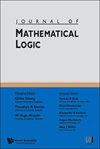Coarse groups, and the isomorphism problem for oligomorphic groups
IF 0.9
1区 数学
Q1 LOGIC
引用次数: 2
Abstract
Let [Formula: see text] denote the topological group of permutations of the natural numbers. A closed subgroup [Formula: see text] of [Formula: see text] is called oligomorphic if for each [Formula: see text], its natural action on [Formula: see text]-tuples of natural numbers has only finitely many orbits. We study the complexity of the topological isomorphism relation on the oligomorphic subgroups of [Formula: see text] in the setting of Borel reducibility between equivalence relations on Polish spaces. Given a closed subgroup [Formula: see text] of [Formula: see text], the coarse group [Formula: see text] is the structure with domain the cosets of open subgroups of [Formula: see text], and a ternary relation [Formula: see text]. This structure derived from [Formula: see text] was introduced in [A. Kechris, A. Nies and K. Tent, The complexity of topological group isomorphism, J. Symbolic Logic 83(3) (2018) 1190–1203, Sec. 3.3]. If [Formula: see text] has only countably many open subgroups, then [Formula: see text] is a countable structure. Coarse groups form our main tool in studying such closed subgroups of [Formula: see text]. We axiomatize them abstractly as structures with a ternary relation. For the oligomorphic groups, and also the profinite groups, we set up a Stone-type duality between the groups and the corresponding coarse groups. In particular, we can recover an isomorphic copy of [Formula: see text] from its coarse group in a Borel fashion. We use this duality to show that the isomorphism relation for oligomorphic subgroups of [Formula: see text] is Borel reducible to a Borel equivalence relation with all classes countable. We show that the same upper bound applies to the larger class of closed subgroups of [Formula: see text] that are topologically isomorphic to oligomorphic groups.粗糙群,以及少纯群的同构问题
令[公式:见文]表示自然数排列的拓扑群。如果对于每个[公式:见文],其对[公式:见文]-自然数元组的自然作用只有有限多个轨道,则[公式:见文]的封闭子群[公式:见文]被称为寡胚。在波兰空间上等价关系之间Borel约化的情况下,研究了[公式:见文]的低纯子群上拓扑同构关系的复杂性。给定[公式:见文]的一个闭子群[公式:见文],粗群[公式:见文]是具有[公式:见文]的开子群的余集域和三元关系[公式:见文]的结构。这个结构来源于[公式:见文],在[A]中被引入。Kechris, A. Nies和K. Tent,拓扑群同构的复杂性[j].符号逻辑83(3)(2018):190 - 1203,Sec. 3.3。如果[Formula: see text]只有可数的开放子群,则[Formula: see text]是一个可数结构。粗群是我们研究此类封闭子群的主要工具[公式:见原文]。我们将它们抽象地公理化为具有三元关系的结构。对于低纯群和无限群,我们在群和相应的粗群之间建立了stone型对偶。特别地,我们可以用Borel的方式从[Formula: see text]的粗群中恢复一个同构副本。我们利用这个对偶证明了[公式:见文]的低纯子群的同构关系是Borel可约为所有类可数的Borel等价关系。我们证明了相同的上界适用于[公式:见文本]中拓扑同构于寡纯群的更大的闭子群类。
本文章由计算机程序翻译,如有差异,请以英文原文为准。
求助全文
约1分钟内获得全文
求助全文
来源期刊

Journal of Mathematical Logic
MATHEMATICS-LOGIC
CiteScore
1.60
自引率
11.10%
发文量
23
审稿时长
>12 weeks
期刊介绍:
The Journal of Mathematical Logic (JML) provides an important forum for the communication of original contributions in all areas of mathematical logic and its applications. It aims at publishing papers at the highest level of mathematical creativity and sophistication. JML intends to represent the most important and innovative developments in the subject.
 求助内容:
求助内容: 应助结果提醒方式:
应助结果提醒方式:


